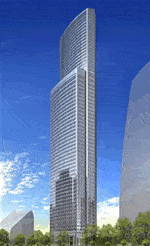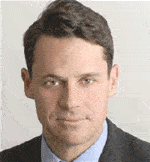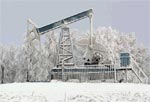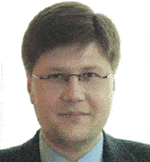Russia’s greatest strength could also turn out to be its biggest weakness.
 |
|
Skyscrapers go up as some of Russia’s surplus is invested in infrastructure projects |
Oil has been kind to Russia. In the past few years, as world commodity prices have soared, Russia has amassed more liquidity than it knows what to do with. Its foreign exchange reserves are tipped to reach $434 billion by the end of this year as capital inflows continue to surge. “Russia’s large FX reserves dwarf their external financing gap from the debt side,” notes Martin Blum, head of EEMEA (Eastern Europe, Middle East and Africa) economics and FI/FX strategy for UniCredit. “It gives policymakers in Russia the ability in the coming years to achieve what they like with key variables and the exchange rate as they will have significant FX reserves to support their policies.”
Unlike some of its Central and Eastern European neighbors, which are running high current account deficits, last year Russia ran a current account surplus of $94 billion (9.6% of GDP), and the federal budget has been in surplus since the start of the millennium. “In financial terms, Russia is the strongest emerging market in the region,” says Blaise Antin, head of global emerging markets for TCW, which is owned by Société Générale Asset Management (SGAM). “Public debt has dropped to remarkably low levels, and external debt [3.7% of GDP declining to 2.2% by 2009] has almost gone.”
Economic growth is also picking up. After averaging 6.5% prior to 2006, ratings agency Fitch predicts real GDP growth of 7.7% this year for Russia. And although doing business in Russia is still marred by bureaucracy, a lack of transparency and corruption, this is overshadowed by foreign investors’ eagerness to secure a stake in the country’s booming consumer sector. Net foreign direct investment (FDI) into Russia is at an all-time high. According to Fitch, FDI into Russia was $31 billion in 2006 compared with $13 billion in 2005, and this year also looks to be another record breaker with FDI levels in the first half hitting $25 billion.
In the past two years foreign investment has also poured into non-commodities such as beverages, car manufacturing, real estate, property management and telecom, says Gintaras Shlizhyus, a CEE analyst with RZB. Yet while foreign investment in the consumer goods sector may be seemingly unfettered, the same cannot be said of the oil and gas industry, where Western companies such as Royal Dutch Shell have found themselves on the sharp end of increasingly protectionist government policies.
 |
|
Foreign investors are eager to secure a stake in Russia’s booming consumer sector, despite high levels of bureaucracy, corruption and a lack of transparency |
Responding to foreign investors’ calls for greater clarification as to those strategic investment sectors where majority shareholdings by foreigners are not welcomed, a draft “Strategic Sectors Law” is currently pending in the Russian parliament. Blum of UniCredit says foreign investment levels could have been even higher if Russia had not adopted a protectionist stance toward some industry sectors. Arguably, he says, a country at Russia’s stage of economic development should be attracting even higher levels of foreign investment. Given its susceptibility to a commodity price shock, others believe Russia needs to take a longer-term perspective when it comes to foreign investment.
Although at the time of writing Brent crude oil prices were hovering around $100 a barrel, if oil prices slide significantly, Russia could move into a current account deficit by 2009. As much as oil has been good to Russia, it is also its biggest weakness. “Russia’s dependence on commodity prices is a constraint on its rating, as it exposes it to potential macroeconomic volatility and challenges in terms of income inequality,” explains Fitch. And although manufacturing output, which grew 12% year-on-year in the first half of 2007 according to Fitch, may be growing at a faster rate than oil and gas, which is turning in 2% to 3% growth per annum, questions remain as to whether Russia’s economy has diversified enough beyond oil to withstand yet another price shock.
 |
|
Antin: Over time the quashing of effective political opposition could heighten “great man risk” |
Unlike in 1998, when declining world commodity prices tipped the economy over the edge, now Russia boasts substantial reserves, which are likely to reduce the impact of any immediate shock. And although the federal budget is reliant on oil and gas revenues, in the past few years Russia has diversified its tax base. It has also accumulated a fairly substantial stabilization fund—approximately $128 billion by the end of July this year—to help withstand any oil price shocks.
While it is trying to prepare for the worst, Russia is still exposed to the risk of what analysts term “Dutch disease,” where boom conditions in the oil and gas sector can render other sectors of the economy uncompetitive by inflating the exchange rate. “To a certain extent, that is happening in Russia,” says Antin, although Blum believes there is no strong evidence that the non-oil sector is suffering too much yet from real appreciation of the ruble as a result of high oil prices. “But it could in the future,” he says, particularly given that industry restructuring has not been that significant.
Despite its substantial liquidity buffer, Russia is sensitive to what is happening in the global credit markets. According to ING Bank, the Russian government’s verbal intervention in September had no impact on the money market, and in early October the three-month interbank prime rate climbed to 7.58%, an increase of 40 basis points, the highest level seen in the past two years.
Analysts have also expressed reservations about the speed of credit expansion in Russia’s banking sector, which they say raises risks. According to Fitch, bank credit growth to the private sector is tipped to reach 50% in 2007, up from 48% in 2006. Fitch is concerned that if banking credit expands too rapidly, credit standards and asset quality could weaken. Fitch says there are more than 900 banks with capital of less than E10 million. Russian banks have also notched up higher levels of external debt, which according to Fitch increased from $32 billion at the end of 2004 to $101 billion—or 10% of GDP—by the end of 2006.
 |
|
Feeling the chill: Boom conditions in the oil and gas sectors may render other sectors of the economy uncompetitive by inflating the ruble exchange rate |
Inflation Looms
Although Russia boasts sufficient liquidity to pump into the banking sector in the event of any crisis, perhaps the biggest challenge it faces is how to spend its liquidity cash pot wisely. Analysts caution that Russia should not extend open-ended assistance to domestic banks, and they also warn that increased fiscal spending in general is likely to put additional strain on Russia’s liquidity pot over time.
“The disappearance of the current account surplus appears inevitable as Russia spends more of its terms-of-trade windfall, particularly on investment,” Fitch says. While most analysts believe Russia is right to reduce what they consider its abnormally high surplus—if it is invested in social projects, for example—but if that feeds through to consumer spending, it could push inflation higher. “That is a credible threat policymakers need to take into account,” says Shlizhyus.
Although inflation is nowhere near 1998 levels, Russia is unlikely to bring inflation down to its 8% target. Inflation is expected to reach 8.7% in the 12 months to July this year. The government has implemented what Antin describes as unorthodox measures by pressuring retailers to freeze prices on some staple goods. Yet it is only considered to be a stopgap measure as the government “cannot freeze food prices indefinitely,” Antin says.
 |
|
Shilizhyus: Russia still retains many wild west elements, but it has made tremendous progress |
There is also likely to be some fiscal loosening in the run-up to December’s parliamentary elections and March’s presidential elections. If president Vladimir Putin’s United Russia party wins the forthcoming parliamentary elections by a landslide, some suggest he may not disappear from politics altogether. “If United Russia does exceptionally well in the Duma elections, and if the president who is elected is someone Putin agrees with, he could stand as the next prime minister,” says Blum.
The re-election of United Russia and continued visibility of popular figures such as Putin would ensure a smooth political transition and policy consistency, but that all hinges on who the presidential candidate is. Although Putin is popular and a known quantity, Antin says that over time the quashing of effective political opposition could heighten the prospect of “great man risk”: What happens if Putin goes away?
With political competition stifled and the economy still marred by corruption and a lack of transparency, some believe World Trade Organization membership, which Russia has been negotiating for some time, may be a way of stimulating further structural reforms. Yet Shlizhyus believes Russia will not accept WTO membership at any price.
That is not to say that it has not come a long way. “If you compare Russia today to 20 years ago, it is not the ‘Wild West’ anymore,” says Shlizhyus. “It still retains many ‘Wild West’ elements, but it has definitely made tremendous progress. Still there is a tremendous amount of work to be done.”
Anita Hawser



